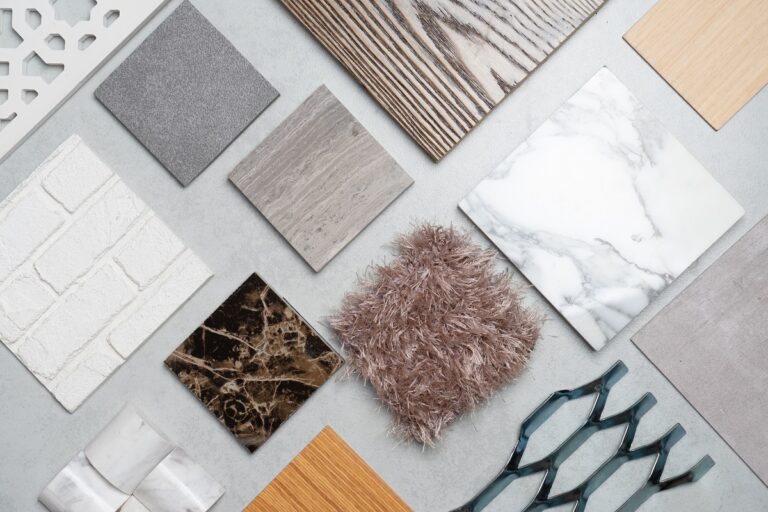You’ve poured your heart into creating a genius design concept. Now you need to find, customize, order, and manage the delivery of the many components required to bring that concept to life. This includes furnishings, decorative accessories, flooring, hardware, window treatments, and more.
This time-consuming, and often complex, process is known as sourcing and procurement. But before we dive into how exactly to perfect your process, let’s define what the terms Sourcing and Procurement actually mean.
Table of Contents
Interior design sourcing and procurement 101
Sourcing is the process of identifying, assessing, and selecting suppliers and vendors who can provide the required goods, services, or materials needed for your project. It involves researching, evaluating, and establishing relationships with potential suppliers to acquire the best quality products or services at the most competitive prices.
Procurement involves the actual acquisition, purchasing, and management of those goods or services, which you identified while sourcing. It covers all the steps of purchasing, including transactions and contracts, as well as managing relationships with your chosen suppliers.
The interior design procurement process
The procurement process is all about selecting, purchasing, and coordinating everything needed to make your space come together. Whether you’re working on a cozy home, a sleek office, or a chic hotel, getting procurement right is key to making your client’s design dreams come true without breaking the bank or missing deadlines.
Step 1. Planning and budgeting
Before you start shopping, it’s essential to have a solid game plan. This means understanding what your client wants, what the project involves, and how much you can spend. A well-thought-out procurement plan will list all the items you need—like furniture, lighting, and finishes—along with details like quantities and prices. And, of course, keeping an eye on the budget from the start helps avoid any nasty surprises later on.
Step 2. Sourcing and vendor selection
With your plan in hand, it’s time to find the perfect pieces to bring your design to life. This involves scouting out vendors and suppliers who can offer the right products at the right price. Building good relationships with reliable vendors is a game-changer—they can offer you better deals, insider tips, and quicker turnaround times. Remember, it’s not just about finding what looks good; you’ll also need to consider factors like delivery times, warranties, and customer service.
Step 3. Order management
Now that you’ve picked out your items, the next step is managing the orders. This means placing orders with your chosen vendors, making sure they’ve got all the details right, and tracking everything to ensure it arrives on time. Good communication with vendors is crucial here—you’ll want to stay on top of lead times and deal with any hiccups as they come. Plus, keeping an eye on inventory ensures you’ve got everything you need when you need it, helping the project stay on schedule.
Step 4. Quality control
When your items arrive, it’s inspection time. You’ll want to make sure everything matches the specs and meets the quality standards you expected. This step is super important for keeping the integrity of your design intact. If anything is off—whether it’s damaged, defective, or just not right—it’s essential to work with the vendor to sort it out quickly, either through repairs or replacements.
Step 5. Installation
The final stage of procurement is getting everything into the space. Coordinating the installation of all the pieces you’ve carefully selected requires detailed planning and teamwork. You’ll need to work closely with contractors, installers, and other professionals to make sure everything gets installed in the right order and without any snags.
Once everything is in place, it’s time to step back and take a good look. This post-installation review is about making sure everything lines up with the original design vision. You’ll want to check that all elements are functional, properly placed, and up to snuff. If there are any last-minute tweaks needed, now’s the time to handle them. The goal is to wrap up the project with a space that meets and exceeds expectations.
7 ways to excel at sourcing and procurement
So, how can you become a master of sourcing and procurement? Read on for our 7 best tips.
1. Set and manage clients’ expectations
The foundation of a successful sourcing and procurement strategy begins with transparent communication. To avoid conflicts about pricing, be upfront with your clients about the whys and hows of your fee. Help them understand what exactly goes into your process, and how it provides them with a higher level of quality, customization, and service than purchasing from retailers. By setting realistic expectations with your clients early on, you establish trust, head off price shopping, and ensure a smoother collaboration.
2. Do your research
In the world of design, knowledge is power. Staying up to date on emerging trends, materials, and suppliers will give you the tools and the know-how for more mindful and efficient sourcing. Engaging with industry publications, like Architectural Digest and Business of Home, attending trade shows, like High Point Market and Maison et Objet, and leveraging online platforms, like Chairish and 1stdibs, which are dedicated to design inspiration, will keep your finger on the pulse of the industry.
3. Establish and cultivate to-the-trade relationships
Building strong relationships with to-the-trade vendors is invaluable in creating customized selections for your clients, negotiating better terms, gaining access to exclusive offerings, receiving top-notch service, and managing challenges with ease.
So when it comes to establishing these relationships, where do you begin? Most vendors, showrooms, and wholesalers include trade account applications online, though some require you to call them directly. To apply, you’ll need the following:
- Proof of business
- Current business or state professional license
- Tax ID or EIN
- Resale certificate (You apply for this directly with the state where your business operates.)
- Business bank account
- Accreditation certification (For example, NCIDQ, CCIDC, or proof of membership in a professional organization like ASID, AIA, or IIDA.)
The application process usually takes between 2-5 days to complete.
Once you’ve established these relationships, remember to maintain open lines of communication and showcase mutual respect. Investing in nurturing your connections can lead to long-term partnerships that extend well beyond a single project.
4. Source smart
If setting up individual trade accounts with each vendor feels too time-consuming or you prefer to avoid managing product orders, consider using one-stop shop marketplaces like the ones we’ve listed below.
With these platforms, you can access hundreds of trade vendor collections in one place instead of having to set up individual accounts.
These companies not only give you access to high-commission products, but they also take over order placement and management so you don’t have to. You’ll get proactive order updates throughout the process. Make sure to also partner with a receiving warehouse to store incoming furniture until you’re ready for installation.
Ready to be inspired? Interior designer Kimberly Horton shifted from a 100% retail purchasing model to 80% wholesale. By making this shift, plus raising her design fees, she increased her annual revenue from $8K in her first year of business to $200K+ by year 7. While Kimberly’s process was gradual, she still managed to double or triple her net income every year.
Check out our in-depth webinar on shopping wholesale with Kimberly Horton for a fool-proof roadmap to boosting your profits.
5. Use time-saving software
Streamline your operations with specialized software, like DesignFiles. Using DesignFiles during the sourcing stage enables you to save items in seconds via a handy browser clipper, generate detailed product lists, let clients approve and decline products, and create branded tearsheets for any product. During procurement, you can use DesignFiles to submit and track product orders, keep clients in the loop, making your projects run much smoother.
6. Implement systems
Consistency is key. Develop standardized processes for sourcing and procurement that can be replicated across projects. Whether it’s creating templates for purchase orders (DesignFiles can help with this!) or establishing a workflow for vendor communication, having repeatable systems in place will supercharge your efficiency and minimize errors. When designing your systems, a good place to start is by breaking down into steps the processes you follow for both Sourcing and Procurement, and creating checklists to ensure no detail slips through the cracks.
7. Curate an onsite library
DesignFiles is also a great resource for building a virtual library, which you can draw upon for future projects. I also recommend curating a collection of actual physical samples, featuring materials, fabrics, and finishes. This resource will help clients touch, feel, and experience the potential elements of their space firsthand, and streamline their decision-making.
Top 3 interior design procurement software
These platforms serve as comprehensive hubs, allowing interior designers to source products from multiple vendors in one convenient place, streamlining the procurement process.
1. Daniel House
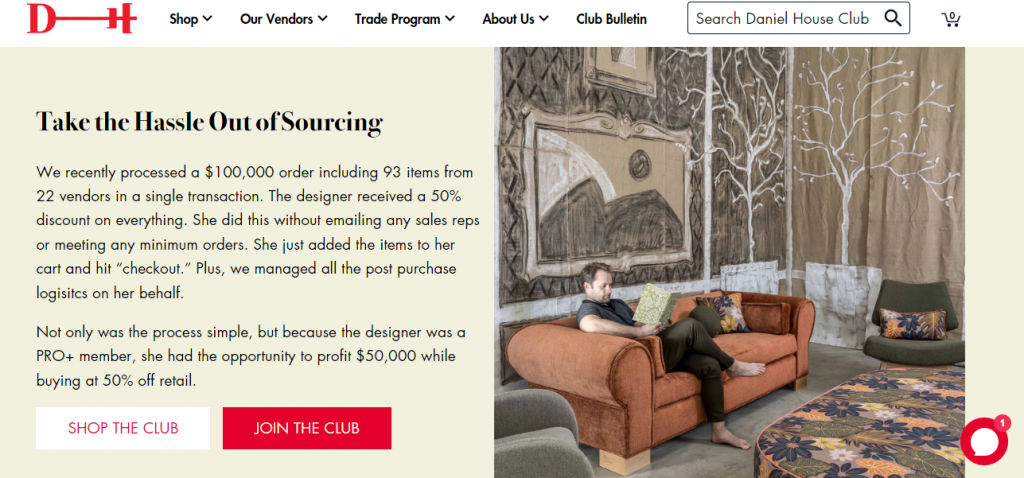
Daniel House offers one of the most generous commission structures in the industry. As a designer, you can source products from over 100 vendors at up to 50% off retail prices. You have the flexibility to either keep the entire commission for yourself or offer a slight discount to your clients off the Manufacturer’s Suggested Retail Price (MSRP).
What sets Daniel House apart is the convenience it provides by eliminating the need to contact multiple vendors or coordinate deliveries. You manage everything through one streamlined platform, saving you valuable time and effort.
Learn more about Daniel House.
2. SideDoor
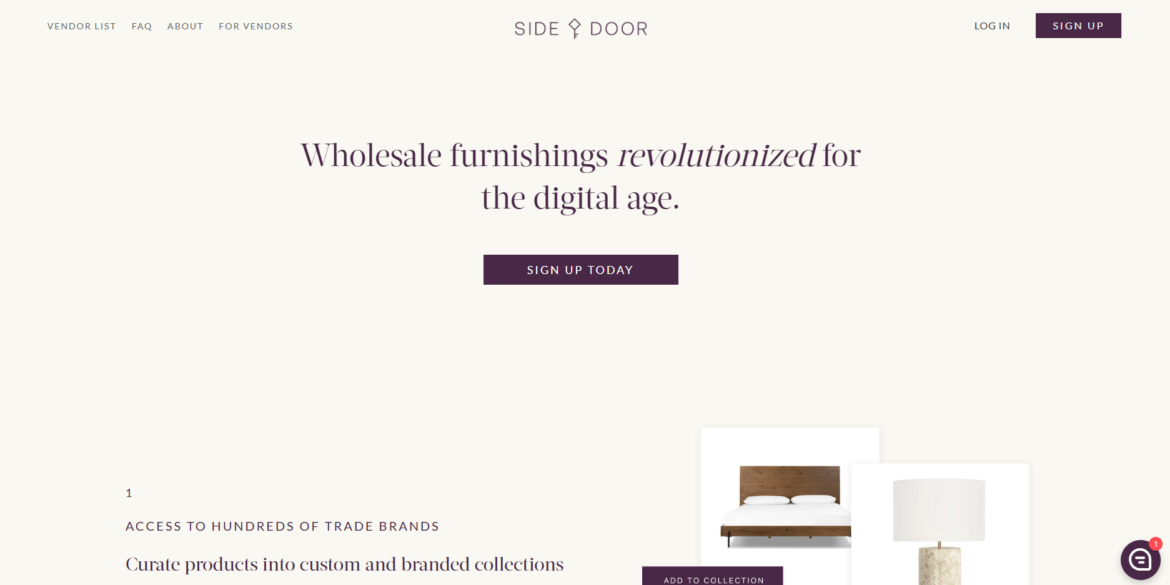
SideDoor simplifies product sourcing by giving designers access to trade-only products from over 200 well-known vendors. They handle all aspects of the order process, including management and delivery, at no cost to you.
What’s truly unique about SideDoor is the ability to create shoppable collections for your clients. If you’d prefer to let your clients shop independently, you can direct them to your customized collection page where they can purchase items themselves. SideDoor will manage everything from order processing to delivery, providing a hassle-free experience for both you and your clients.
If you’re looking to monetize your social content and maximize your earnings, SideDoor can help you achieve that. By sourcing trade-only products, you can boost your commission to an average of 30% per order, compared to the 2%-7% earned through standard affiliate links. This makes it an excellent option for designers who want to earn more while providing top-quality products to their clients.
Learn more about SideDoor. And be sure to check out the DesignFiles and SideDoor integration to learn how you can easily incorporate their products into your designs.
3. The Designer’s Collaborative

The Designers’ Collaborative is a powerful procurement network that allows designers to tap into hundreds of trade accounts from a single platform. By leveraging the collective purchasing power of designers, the network opens trade accounts with various vendors, securing products at the lowest possible prices—ensuring the highest possible margins for you.
To access this network, there’s an annual fee of $370, but the designer discounts you gain can easily yield a multiple return on your investment. It’s an excellent solution for designers looking to optimize their margins and access a wide range of products.
Learn more about the Designers’ Collaborative.
Top 3 interior design software for tracking product orders
Looking for software that makes the whole process of tracking and managing your orders much easier?
Consider one of these platforms.
1. DesignFiles
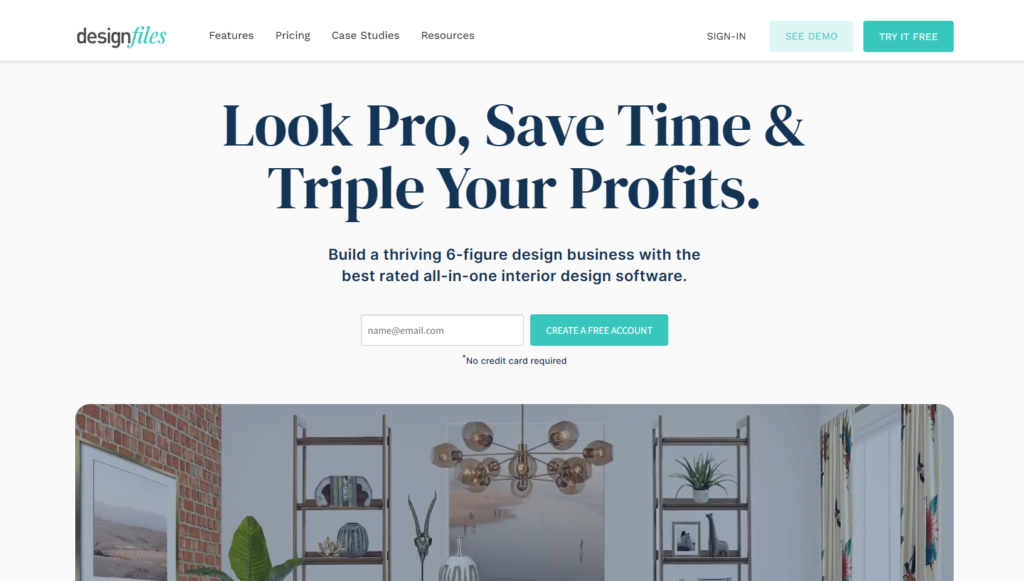
The platform simplifies everything from product sourcing to creating and submitting purchase orders, to managing and tracking every order with their product tracker. It also provides a client facing tracker so your clients can log in and get regular updates vs constantly calling or texting you for updates. Designers can efficiently source products online, organize them in a personal library, and seamlessly integrate them into design boards, invoices, purchase orders, presentations, and more. With automated tools for generating detailed product lists and vendor purchase orders, DesignFiles eliminates many of the manual tasks involved in procurement, allowing designers to focus on creativity and client satisfaction.
Key features for procurement include:
- Product clipper for easy online sourcing
- Personal product library for organization
- Branded purchase orders and RFQs
- Order tracker with status updates
- Client facing order tracker that provides regular updates
- Task management and team collaboration tools
- Vendor contact list
- Project level order tracking
2. Studio Designer
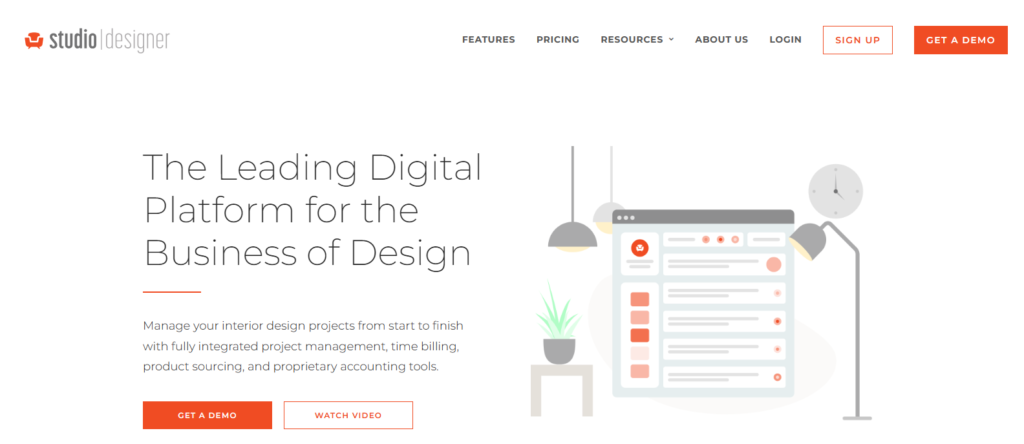
Studio Designer is another popular platform among interior designers. The software offers tools to streamline purchasing, from tracking orders to managing budgets. Designers can keep their procurement process organized by utilizing features like order status tracking and budget management.
Key features for procurement include:
- Product clipper for easy online sourcing
- Order status tracking
- Budget management tools
- Vendor management integration
- Centralized order history for easy reference
3. Design Manager
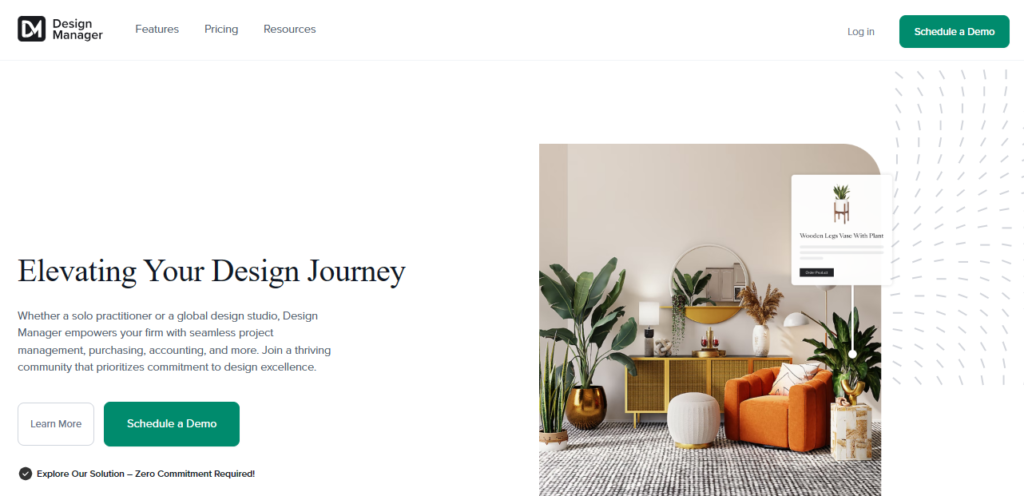
Another interior design software to consider is Design Manager. This platform allows designers to manage purchasing and inventory from one place. Design Manager also includes project management, accounting, and reporting tools, making it a great solution for larger design studios. However, it doesn’t include design tools, so you’ll need to layer on other software for 3D floor planning and moodboards.
Key features for procurement include:
- Integrated purchasing and accounting modules
- Inventory management
- Purchase order generation
- Vendor and order tracking
Key takeaways
Ultimately, it’s important to remember mastering sourcing and procurement is an ongoing journey. It requires adaptability, foresight, and commitment.
It might sound complicated and time-consuming, but it’s so worth the up-front investment. Purchasing wholesale and marking up products is essential to making a profit and growing your business. And once you get sourcing and procurement down to a science, you’ll be able to save tons of valuable time and stress, stay on track and on budget, while also delivering final results that thrill your clients, again and again.


